|
DARKNESS AT NOON
While the Hebrew Prophets predicted Darkness at Noon, what were the
“other nations” expecting as they awaited the Return of Nibiru?
To judge by their written records and engraved images, they were
expecting the resolution of the gods’ conflicts, benevolent times
for mankind, and a great theophany. They were in, as we shall see,
for an immense surprise.
In anticipation of the great event, the cadres of priests observing
the skies in Nineveh and Babylon were mobilized to note celestial
phenomena and interpret their omens. The phenomena were meticulously
recorded and reported to the kings. Archaeologists have found in the
remains of royal and temple libraries tablets with those records and
reports that in many instances were arranged according to subject or
the planet they were observing.
A well-known collection in which
some seventy tablets were combined—in antiquity— was a series titled Enuma Anu Enlil; it reported observations of planets, stars, and
constellations classified according to the celestial Way of Anu and
Way of Enlil—encompassing the skies from 30 degrees south all the
way to zenith in the north (see Fig. 53).
At first the observations were interpreted by comparing the
phenomena to astronomical records from Sumerian times. Though
written in Akkadian (Babylon’s and Assyria’s language), the
observational reports extensively used Sumerian terminology and
mathematics and sometimes included a scribal note that they were
translated from earlier Sumerian tablets.
Such tablets served as
“astronomers’ manuals,” telling them from past experience what a
phenomenon’s oracular meaning was:
When the Moon in its calculated time is not seen:
There will be an invasion of a mighty city.
When a comet reaches the path of the Sun:
Field-flow will be diminished,
an uproar will happen twice.
When Jupiter goes with Venus:
The prayers of the land will reach the gods.
As time went on, the reports were increasingly of observations
accompanied by the omen-priests’ own interpretations: “In the night
Saturn came near to the Moon. Saturn is a planet of the Sun. This is
the meaning: It is favorable to the king.” The noticeable change
included the paying of particular attention to eclipses; a tablet
(now in the British Museum), listing computer-like columns of
numbers, served to predict lunar eclipses fifty years in advance.
Modern studies have concluded that the change to the new style of
topical astronomy took place in the eighth century
b.c.e. when, after a period of mayhem and royal upheavals in Babylon
and Assyria, the two lands’ fates were placed in new and strong
royal hands: Tiglath-Pileser III (745–727 b.c.e.) in Assyria and
Nabunassar (747–734 b.c.e.) in Babylonia.
Nabunassar (“By Nabu protected”) was hailed, already in antiquity,
as an innovator and powerhouse in the field of astronomy. One of his
first actions was to repair and restore the temple of Shamash in
Sippar, the Sun-god’s “cult center” in ancient Sumer. He also built
a new observatory in Babylon, updated the calendar (a heritage from
Nippur), and instituted daily reporting to the king of the celestial
phenomena and their meaning.
It was primarily due to those measures
that a wealth of astronomical data, shedding light on subsequent
events, has come to light.
Tiglath-Pileser III was also active, in his own ways. His annals
describe constant military campaigns and boast of captured cities,
brutal executions of local kings and nobility, and mass exiles. His
role, and those of his successors Shalmaneser V and Sargon II, in
the demise of Israel and the exile of its people (the Ten Lost
Tribes), and then the attempt by Sennacherib to seize Jerusalem,
were described in the previous chapter.
Closer to home, those
Assyrian kings were busy annexing Babylonia by “taking the hands of Marduk.” The next Assyrian king, Esarhaddon (680–669 b.c.e.),
announced that “both Ashur and Marduk gave me wisdom,” swore oaths
in the name of Marduk and Nabu, and started to rebuild the Esagil
temple in Babylon.
In history books, Esarhaddon is mainly remembered for his successful
invasion of Egypt (675–669 b.c.e.). The invasion’s purpose, as far
as it could be ascertained, was to stop Egyptian attempts to “meddle
in Canaan” and dominate Jerusalem. Noteworthy, in the light of
subsequent events, was the route he chose: instead of going the
shortest way, to the southwest, he made a considerable detour and
went northward, to Harran. There, in the olden temple of the god
Sin, Esarhaddon sought that god’s blessing to embark on the
conquest; and Sin, leaning on a staff and accompanied by Nusku (the
Divine Messenger of the gods), gave his approval.
Esarhaddon then did turn southward, sweeping mightily through the
lands of the eastern Mediterranean to reach Egypt. Significantly, he
detoured away from the prize that Sennacherib failed to
seize—Jerusalem. Significantly, too, that invasion of Egypt and the
detour away from Jerusalem—as well as Assyria’s own eventual
fate—had been prophesied by Isaiah decades earlier (10: 24–32).
Busy geopolitically as Esarhaddon was, he did not neglect the
astronomical requirements of those times. With guidance from the
gods Shamash and Adad, he erected in Ashur (the city, Assyria’s cult
center) a “House of Wisdom”—an observatory—and depicted the complete
twelve-member solar system, including Nibiru, on his monuments (Fig.
89).
Leading to a more lavish sacred precinct was a new monumental
gate, built—according to cylinder seal depictions—to
emulate Anu’s gateway on
Nibiru (Fig. 90). It is a clue to what the
Return expectations in Assyria were.
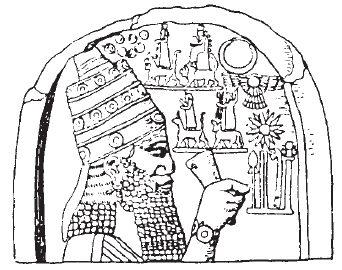
Figure 89
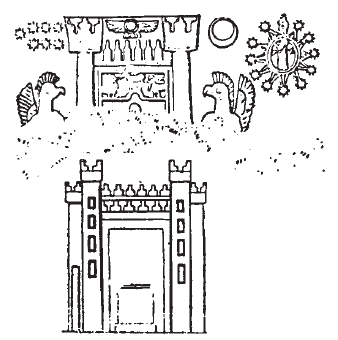
Figure 90
All those religious-political moves suggest that the Assyrians made
sure to “touch all the bases” as far as the gods were concerned. And
so, by the seventh century b.c.e., Assyria was ready for the
anticipated Return of the planet of the gods.
Discovered
texts—including letters to the kings by their chief
astronomers—reveal anticipation of an idyllic, utopian time:
When Nibiru will culminate . . . The lands will dwell securely,
Hostile kings will be at peace; The gods will receive prayers and
hear supplications.
When the Planet of the Throne of Heaven will grow brighter, there
will be floods and rains.
When Nibiru attains its perigee, the gods will give peace. Troubles
will be cleared up, complications will be unravelled.
Clearly, the expectation was of a planet that will appear, rise in
the skies, grow brighter, and at its perigee, at the Crossing,
become NIBIRU (the Cross Planet). And as the gateway and other
construction indicated, with the returning planet a repeat of the
previous visit to Earth by Anu was expected. It was now up to the
astronomer-priests to watch the heavens for that planetary
appearance; but where were they to look in the celestial expanse,
and how would they recognize the planet when still in the distant
skies?
The next Assyrian king, Ashurbanipal (668–630 b.c.e.), came up with
a solution.
Historians consider Ashurbanipal to have been the most scholarly of
the Assyrian kings, for he had learnt other languages besides
Akkadian, including Sumerian, and claimed that he could even read
“writings from before the Flood.” He also boasted that he “learnt
the secret signs of Heaven and Earth . . . and studied the heavens
with the masters of divination.”
Some modern researchers also consider him to have been “The First
Archaeologist,” for he systematically collected tablets from sites
that were already ancient in his time—like Nippur, Uruk, and Sippar
in what used to be Sumer. He also sent specialized teams to sort out
and loot such tablets from the capitals that the Assyrians overran.
The tablets ended up in a famed library where teams of scribes
studied, translated, and copied chosen texts from the previous
millennia.
(A visitor to the Museum of the Ancient Near East in
Istanbul can see a display of such tablets, neatly arranged on the
original shelves, with each shelf headed by a “catalog tablet” that
lists all the texts on that shelf .)
While the subjects in the accumulated tablets covered a wide range,
what was found indicates that particular attention was given to
celestial information. Among the purely astronomical texts there
were tablets that belonged to a series titled “The day of Bel”—the
Day of the Lord! In addition, epic tales and histories pertaining to
the gods’ comings and goings were deemed important, especially if
they shed light on Nibiru’s passages.
Enuma elish—the Epic of
Creation that told how an invading planet joined the solar system to
become Nibiru—was copied, translated, and recopied; so were writings
dealing with the Great Flood, such as the Atra-Hasis Epic and the
Epic of Gilgamesh. While they all seem to legitimately be part of
accumulating knowledge in a royal library, it so happens that they
all dealt with instances of Nibiru’s appearances in the past—and
thus with its next nearing.
Among the purely astronomical texts translated and, undoubtedly,
carefully studied, were guidelines for observing Nibiru’s arrival
and for recognizing it on its appearance. A Babylonian text that
retained the original Sumerian terminology stated:
Planet of the god Marduk:
Upon its appearance SHUL.PA.E;
Rising thirty degrees, SAG.ME.NIG;
When it stands in the middle of the sky: NIBIRU.
While the first-named planet (SHUL.PA.E) is deemed to be Jupiter
(but could be Saturn), the next one’s name (SAG.ME.NIG) could just
be a variant for Jupiter, but is considered by some to be Mercury
(*).
* The extensive astronomical data that have been found attracted,
already in the 19th and early in the 20th centuries, the time,
attention, and patience of scholarly giants who brilliantly combined
“Assyriology” with knowledge of astronomy. The very first book of
The Earth Chronicles, The 12th Planet, covered and used the work and
achievements of the likes of Franz Kugler, Ernst Weidner, Erich
Ebeling, Herman Hilprecht, Alfred Jeremias, Morris Jastrow, Albert
Schott, and Th. G. Pinches, among others.
Their task was complicated
by the fact that the same kakkabu (any celestial body, including
planets, fixed stars, and constellations) could have more than one
name. I also pointed out right then and there the most basic failing
of their work: they all assumed that the Sumerians and other ancient
peoples had no way of knowing (“with the naked eye”) about planets
beyond Saturn. The result was that whenever a planet was named other
than the accepted names for the “seven known kakkabani”—Sun, Moon,
Mercury, Venus, Mars, Jupiter, Saturn—it was assumed to just be yet
another name for one of those “known seven.”
The principal victim of
that erroneous stance was Nibiru; whenever it or its Babylonian
equivalent “planet Marduk” was listed, it was assumed to be another
name for Jupiter or Mars or (in some extreme views) even for
Mercury. Incredibly, modern establishment astronomers continue to
base their work on that “only seven” assumption—in spite of the vast
contrary evidence that shows that the Sumerians knew the true shape
and composition of our solar system, starting with the naming of the
outer planets in Enuma elish, or the 4,500year-old depiction of the
complete twelve-member solar system, with the Sun in the center, on
cylinder seal VA/243 in the Berlin Museum (Fig. 91), or the
depiction of twelve planetary symbols on Assyrian and Babylonian
monuments, etc.
A similar text from Nippur, rendering the Sumerian planetary
names as UMUN.PA.UD.DU and SAG.ME.GAR, suggested that the arrival of
Nibiru will be “announced” by the planet Saturn, and after rising 30
degrees will be near Jupiter. Other texts (e.g., a tablet known as
K.3124) state that after passing SHUL.PA.E and SAG.ME.GAR—which I
believe mean Saturn and Jupiter—“Planet Marduk” will “enter the Sun”
(i.e., reach Perigee, closest to the Sun) and “become Nibiru.”
Other texts provide clearer clues in regard to Nibiru’s path, as
well as to the time frame for its appearance:
From the station of Jupiter,
the planet passes toward the west.
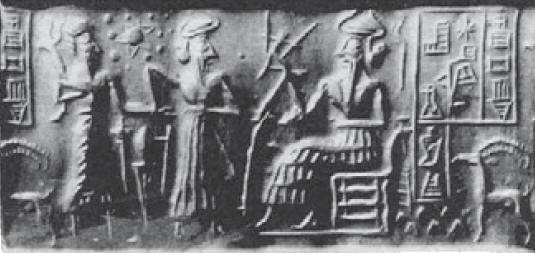
Figure 91
From the station of Jupiter
the planet increases its brilliance,
and in the zodiac of Cancer will become Nibiru.
The great planet:
At his appearance: Dark red.
The heaven he divides in half
as it stands in Nibiru.
Taken together, the astronomical texts from the time of Ashurbanipal
described a planet appearing from the solar system’s edge, rising
and becoming visible when it reaches Jupiter (or even Saturn before
that), and then curving down toward the ecliptic.
At its perigee,
when it is closest to the Sun (and thus to Earth), the planet—at the
Crossing—becomes Nibiru “in the zodiac of Cancer.” That, as the
enclosed schematic (and not to scale) diagram shows, could happen
only when sunrise on the day of the Spring Equinox took place in the
Age of the Ram—during the zodiacal age of Aries (Fig. 92).
Such clues regarding the orbital path of the Celestial Lord and its
reappearance, sometimes using the constellations as a celestial map,
are also found in biblical passages, thereby revealing knowledge
that must have been internationally available:
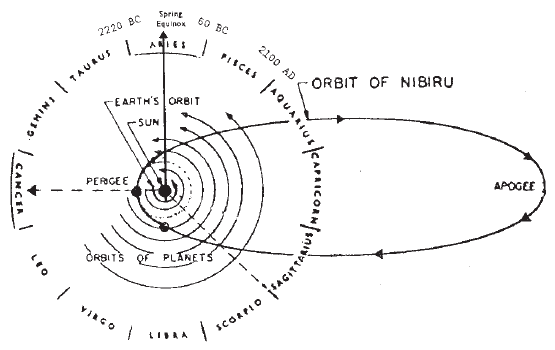
Figure 92
“In Jupiter will thy face be seen,” states Psalm 17.
“The Lord from
the south shall come . . . his shining splendor will beam as light,”
predicted the prophet Habakkuk (Chapter 2).
“Alone he stretches out
the heavens and treads upon the highest Deep; he arrives at the
Great Bear, Sirius and Orion, and the constellations of the south,”
the Book of Job (Chapter 9) stated
The Prophet Amos (5: 9)
foresaw the Celestial Lord “smiling his face upon Taurus and Aries,
from Taurus to Sagittarius he shall go.”
These verses described a
planet that spans the highest heavens and, orbiting
clockwise—“retrograde,” astronomers say—arrives via the southern
constellations. It is a trajectory, on a vaster scale, akin to that
of Halley’s comet (see Fig. 78).
A telling clue in regard to Ashurbanipal’s expectations was the
meticulous rendering into Akkadian of Sumerian descriptions of the
ceremonies attending the state visit of Anu and Antu to Earth circa
4000 b.c.e.
The sections dealing with their stay in Uruk described
how, at evetime, an observer was stationed “on the topmost stage of
the tower” to watch for and announce the appearance of the planets
one after the other, until the “Planet of the Great Anu of Heaven”
came into view, whereupon all the gods assembled to welcome the
divine couple recited the composition,
“To the one who grows bright,
the heavenly planet of the god Anu” and sang the hymn “The Creator’s
image has arisen.”
The long texts then described the ceremonial
meals, the retreat to the nighttime chambers, the processions the
next day, and so on.
One can reasonably conclude that Ashurbanipal was engaged in
collecting, collating, translating, and studying all the earlier
texts that could (a) provide guidance to the astronomer-priests for
detecting, at the first possible moment, the returning Nibiru and
(b) inform the king about the procedures for what to do next.
Calling the planet “Planet of the Heavenly Throne” is an important
clue to the royal expectations, as were the depictions on palace
walls, in magnificent reliefs, of Assyrian kings greeting the god in
the Winged Disc as it hovered above the Tree of Life (as in Fig.
87).
It was important to be informed of the planet’s appearance as soon
as possible in order to be able to prepare the proper reception for
the arrival of the great god depicted within it—Anu himself?—and be
blessed with long, perhaps even eternal, Life.
But that was not destined to be.
Soon after Ashurbanipal’s death, rebellions broke out throughout the
Assyrian empire. His sons’ hold on Egypt, Babylonia, and Elam
disintegrated. Newcomers from afar appeared on the borders of the
Assyrian empire—“hordes” from the north, Medes from the east.
Everywhere, local kings seized control and declared independence. Of
particular importance—immediate and for future events—was Babylon’s
“decoupling” of the dual kingship with Assyria.
As part of the New
Year festival in 626 b.c.e. a Babylonian general whose
name—Nabupolassar (“Nabu his son protects”)—implied that he claimed
to be a son of the god Nabu, was enthroned as king of an independent
Babylonia. A tablet described the start of his investiture ceremony
thus:
“The princes of the land were assembled; they blessed Nabupolassar; opening their fists, they declared him sovereign;
Marduk in the assembly of the gods gave the Standard of Power to
Nabupolassar.”
The resentment of Assyria’s brutal rule was so great that
Nabupolassar of Babylon soon found allies for military action
against Assyria. A principal and freshly vigorous ally was the Medes
(precursors of the Persians), who had experienced Assyrian
incursions and brutality.
While Babylonian troops were advancing
into Assyria from the south, the Medes attacked from the east, and
in 614 b.c.e.—as had been prophesied by the Hebrew
Prophets!—captured and burned down Assyria’s religious capital,
Ashur. The turn of Nineveh, the royal capital, came next. By 612
b.c.e. the great Assyria was in shambles.
Assyria—the land of the
“First Archaeologist”—itself became a land of archaeological sites.
How could that happen to the land whose very name meant “Land of the
god Ashur”? The only explanation at the time was that the gods
withdrew their protection from that land; in fact, we shall show,
there was much more to it: the gods themselves withdrew—from that
land and from Earth.
And then the most astounding and final chapter of the Return Saga,
in which Harran was to play a key role, began to unfold.
The amazing chain of events after the demise of Assyria began with
the escape to Harran of members of Assyria’s royal family. Seeking
there the protection of the god Sin, the escapees rallied the
remnants of the Assyrian army and proclaimed one of the royal
refugees as “King of Assyria”; but the god, whose city Harran has
been since days of yore, did not respond. In 610 b.c.e. Babylonian
troops captured Harran and put an end to the Assyrians’ lingering
hopes.
The contest for the mantle of successorship to the heritage of Sumer
and Akkad was over; it was now worn solely, and with divine
blessing, by the king in Babylon. Again, Babylon ruled the lands
that were once the hallowed “Sumer & Akkad”—so much so that in many
texts from that time, Nabupolassar was given the title “King of
Akkad.” He used that authority to extend the celestial observations
to the erstwhile Sumerian cities of Nippur and Uruk, and some of the
key observational texts from the subsequent crucial years come from
there.
It was in that same fateful year, 610 b.c.e.—a memorable year of
astounding events, as we shall see—that a reinvigorated Egypt also
placed on its throne an assertive strongman named Necho. Just one
year later one of the least understood—by historians, that
is—geopolitical moves then took place.
The Egyptians, who used to be
on the same side as the Babylonians in opposition to Assyrian rule,
emerged from Egypt and, rushing northward, overran territories and
sacred sites that the Babylonians considered theirs. The Egyptian
advance, all the way north to Carchemish, put them within striking
distance of Harran; it also placed in Egyptian hands the two
space-related sites, in Lebanon and in Judea.
The surprised Babylonians were not going to let it stand.
The aging Nabupolassar entrusted the task of recapturing the vital places to
his son Nebuchadnezzar, who had already distinguished himself on the
battlefields. In June 605 b.c.e., at Carchemish, the Babylonians
crushed the Egyptian army, liberated “the sacred forest in Lebanon
which Nabu and Marduk desired,” and chased the fleeing Egyptians all
the way to the Sinai Peninsula. Nebuchadnezzar stopped the pursuit
only on news from Babylon that his father had died. He rushed back,
and was proclaimed King of Babylon that same year.
Historians find no explanation for the sudden Egyptian thrust and
the ferocity of the Babylonian reaction. To us it is evident that at
the core of the events was the expectation of the Return. Indeed, it
seems that in that year 605 b.c.e. the Return was deemed to be
imminent, perhaps even overdue; for it was in that very same year
that the Prophet Habakkuk began to prophecy in the name of Yahweh,
in Jerusalem.
Uncannily foretelling the future of Babylon and other nations, the
Prophet asked Yahweh when the Day of the Lord— a day of judgment
upon the nations, Babylon included—would come, and
Yahweh responded,
saying:
Write down the prophecy,
explain it clearly on the tablets,
so that it may be quickly read:
For the vision there is a set time;
In the end it shall come, without fail!
Though it may tarry, wait for it;
For it will surely come—
For its appointed time it will not be delayed.
Habakkuk 2: 2–3
(The “appointed time,” as we shall see, arrived precisely fifty
years thereafter.)
The forty-three years of Nebuchadnezzar’s reign (605–562 b.c.e.) are
considered a period of a dominant “Neo-Babylonian” empire, a period
marked by decisive actions and fast moves, for there was no time to
lose—the nearing Return was now Babylon’s prize!
To prepare Babylon for the expected Return, massive renovation and
construction works were quickly undertaken. Their focal point was
the sacred precinct, where the Esagil temple of Marduk (now simply
called Bel/Ba’al, “The Lord”) was renovated and rebuilt, its
seven-stage ziggurat readied for viewing from it the starry skies
(Fig. 93)—just as had been done in Uruk when Anu had visited circa
4000 b.c.e.
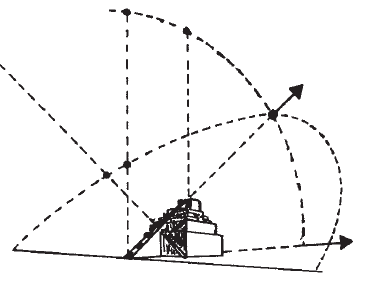
Figure 93
A new Processional Way leading to the sacred precinct
through a massive new gate was erected; their walls were decorated
and covered from top to bottom with artful glazed bricks that
astound to this day, for the site’s modern excavators have removed
and put the Processional Way and the Gate back together at the
Vorderasiatiches Museum in Berlin.
Babylon, Marduk’s Eternal City,
was readied to welcome the Return.
“I have made the city of Babylon to be the foremost among all the
countries and every habitation; its name I elevated to be the most
praised of all the sacred cities,” Nebuchadnezzar wrote in his
inscriptions.
The expectation, it seems, was that the arriving god
of the Winged Disk would come down at the Landing Place in Lebanon,
then consummate the Return by entering Babylon through the new
marvelous Processional Way and imposing gate (Fig. 94)—a gate named
“Ishtar” (alias IN.ANNA), who had been “Anu’s beloved” in Uruk—
another clue regarding whose Return was expected.
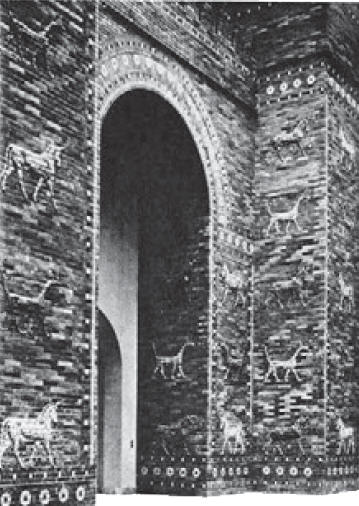
Figure 94
Accompanying these expectations was Babylon’s role as the new Navel
of the Earth—inheriting the prediluvial status of Nippur as the
DUR.AN.KI, the “Bond Heaven-Earth.” That this was now Babylon’s
function was expressed by giving the ziggurat’s foundation platform
the Sumerian name E.TEMEN. AN.KI (“Temple of the Foundation for
Heaven-Earth”), stressing Babylon’s role as the new “Navel of the
Earth”—a role clearly depicted on the Babylonian “Map of the World”
(see Fig. 10).
This was terminology that echoed the description of
Jerusalem, with its Foundation Stone, serving as a link between
Earth and Heaven!
But if that was what Nebuchadnezzar envisioned, then Babylon had to
replace the existing post-Diluvial space link—Jerusalem.
Having taken over Nippur’s prediluvial role to serve as Mission
Control Center after the Deluge, Jerusalem was located at the center
of concentric distances to the other space-related sites (see Fig.
3).
Calling it the “Navel of the Earth”
(38: 12), the Prophet Ezekiel announced that Jerusalem has been
chosen for this role by God himself:
Thus has said the Lord Yahweh:
This is Jerusalem;
In the midst of the nations I placed her,
and all the lands are in a circle
round about her.
Ezekiel 5: 5
Determined to usurp that role for Babylon, Nebuchadnezzar led his
troops to the elusive prize and in 598 b.c.e. captured Jerusalem.
This time, as the Prophet Jeremiah had warned, Nebuchadnezzar was
carrying out God’s anger at Jerusalem’s people, for they had taken
up the worship of the celestial gods:
“Ba’al, the Sun and the Moon,
and the constellations”
(II Kings 23: 5)
—a list that clearly
included Marduk as a celestial entity!
Starving Jerusalem’s people by a siege that lasted three years,
Nebuchadnezzar managed to subdue the city and took the Judean king
Jehoyachin captive to Babylon. Taken into exile were also Judea’s
nobility and learned elite—among them the Prophet Ezekiel—and
thousands of its soldiers and craftsmen; they were made to reside by
the banks of the Khabur River, near Harran, their ancestral home.
The city itself and the Temple were left intact this time, but
eleven years later, in 587 b.c.e., the Babylonians returned in
force. Acting this time, according to the Bible, on their own
volition, the Babylonians put the torch to the Temple that Solomon
built. In his inscriptions Nebuchadnezzar offered no explanation
other than the usual one—to carry out the wishes of and to please
“my gods Nabu and Marduk”; but as we shall soon show, the real
reason was a simple one: a belief that Yahweh had departed and was
gone.
The destruction of the Temple was a shocking and evil deed for which
Babylon and its king—previously deemed by the Prophets to have been
Yahweh’s “rod of wrath”—were to be severely punished:
“The vengeance
of Yahweh our God, vengeance for His Temple,” shall be meted out to
Babylon, announced the Prophet Jeremiah (50: 28).
Predicting the
fall of mighty Babylon and its destruction by invaders from the
north—events that came true just a few decades later—Jeremiah also
proclaimed the fate of the gods whom Nebuchadnezzar had invoked:
Declare among the nations and proclaim,
Raise the sign, announce, do not conceal,
Say: Captured is Babylon!
Withered is Bel, confounded is Marduk!
Jeremiah 50: 2
Divine punishment upon Nebuchadnezzar himself was commensurate with
the sacrilege. Crazed, according to traditional sources, by a bug
that entered his brain through his nose, Nebuchadnezzar died in
agony in 562 b.c.e.
Neither Nebuchadnezzar nor his three bloodline successors (who were
murdered or otherwise disposed of in short shrift) lived to see an
arrival of Anu at the gates of Babylon. In fact, such an arrival
never took place, even though Nibiru did return.
It is a fact that astronomical tablets from that very time record
actual observations of Nibiru, alias “Planet of Marduk.”
Some were
reported as omina, for example, a tablet catalogued K.8688 that
informed the king that if Venus shall be seen “in front of ” (i.e.,
rising ahead of ) Nibiru, the crops will fail, but if Venus shall
rise “behind” (i.e., after) Nibiru, “the crop of the land will
succeed.” Of greater interest to us are a group of “Late Babylonian”
tablets found in Uruk; they rendered the data in twelve monthly
zodiacal columns and combined the texts with pictorial depictions.
In one of these tablets (VA 785l, Fig. 95), the Planet of Marduk,
shown between the Aries ram symbol on one side and the seven symbol
for Earth on the other side, depicts Marduk within the planet.
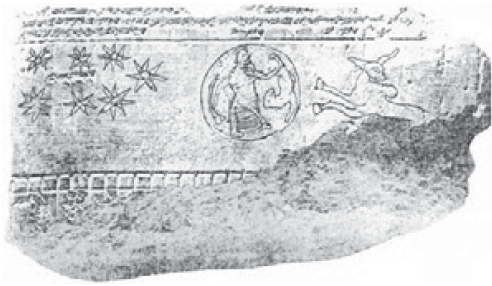
Figure 95
Another example is tablet VAT 7847; it names an actual observation,
in the constellation of Aries, as the “Day when the gate of the
great lord Marduk was opened”— when Nibiru had appeared into view;
and then has an en-try—“Day of the Lord Marduk”—as the planet moved
on and was seen in Aquarius.
Even more telling of the coming
into view of the planet “Marduk” from the southern skies and its
fast becoming “Nibiru” in the central celestial band, were yet another class of
tablets, this time circular. Representing “an advance backward” to
the Sumerian astronomical tenets, the tablets divided the celestial
sphere into the three Ways (Way of Enlil for the northern skies, of
Ea for the southern, and of Anu in the center).
The twelve
zodiacal-calendrical segments were then superimposed on the three
Ways, as shown by the discovered fragments (Fig. 96); explanatory
texts were written on the back sides of those circular tablets.
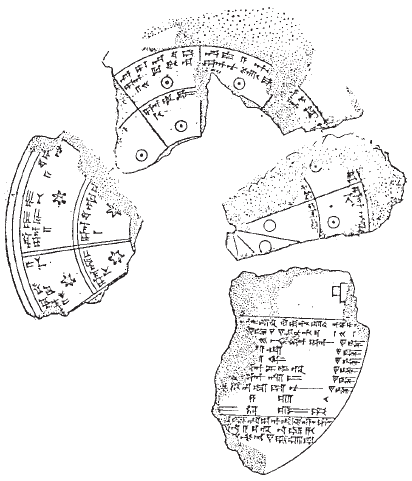
Figure 96
In A.D. 1900, addressing a meeting of the Royal Asiatic Society in
London, England, Theophilius G. Pinches caused a sensation when he
announced that he had succeeded in
piecing together a complete “astrolabe” (“Taker of Stars”), as he
called the tablet.
He showed it to be a circular disc divided into
three concentric sections and, like a pie, into twelve segments,
resulting in a field of thirty-six portions. Each of the thirty-six
portions contained a name with a small circle below it, indicating
it was a celestial body, and a number.
Each portion also bore a
month’s name, so Pinches numbered them from I to XII, starting with
Nissan (Fig. 97).
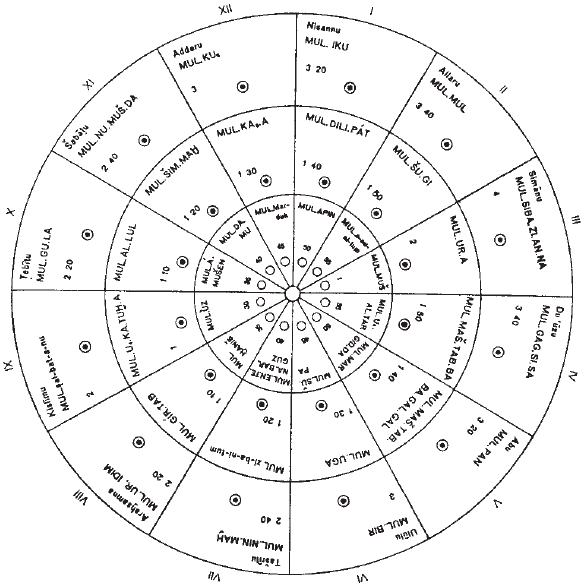
Figure 97
The presentation caused an understandable sensation, for here was a
Babylonian sky map, divided into the three Ways of Enlil, Anu, and
Ea/Enki, showing which planets, stars, and constellations were
observed where at each month during the year. The debate over the identity of the celestial bodies
(at the root of which lurks the notion of “nothing beyond Saturn”)
and the meaning of the numbers has yet to end.
Also unresolved is
the issue of dating—in what year was the astrolabe made, and if it
was a copy of an earlier tablet, what was the time shown? Dating
opinions ranged from before the twelfth century to the third century b.c.e.; most agreed, however, that the astrolabe belonged to the era
of Nebuchadnezzar or his successor Nabuna’id.
The astrolabe presented by Pinches was identified in the ensuing
debates as “P,” but has been later renamed “Astrolabe A” because
another one has since been pieced together and is known as
“Astrolabe B.”
Though the two astrolabes at first glance look identical, they are
different—and for our analysis, the key difference is that in “B”
the planet identified as mul Neberu deity Mar-duk—“Planet Nibiru of
the god Marduk”—is shown in the Way of Anu, the central-ecliptic
band (Fig. 98), whereas in “A” the planet identified as mul
Marduk—the “Planet of Marduk”—is shown in the Way of Enlil, in the
northern skies (Fig. 99).
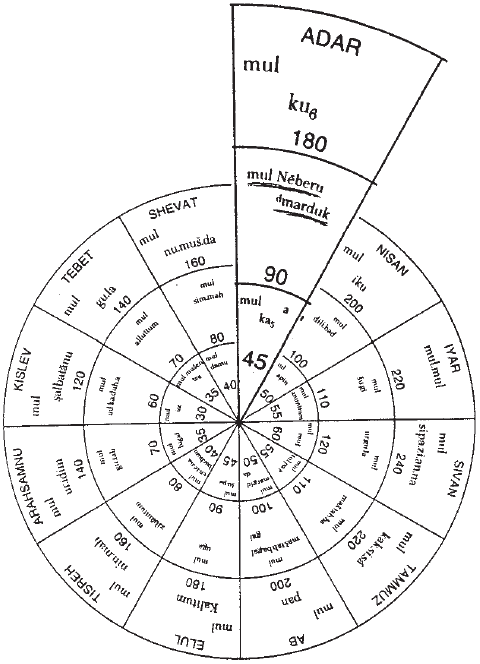
Figure 98
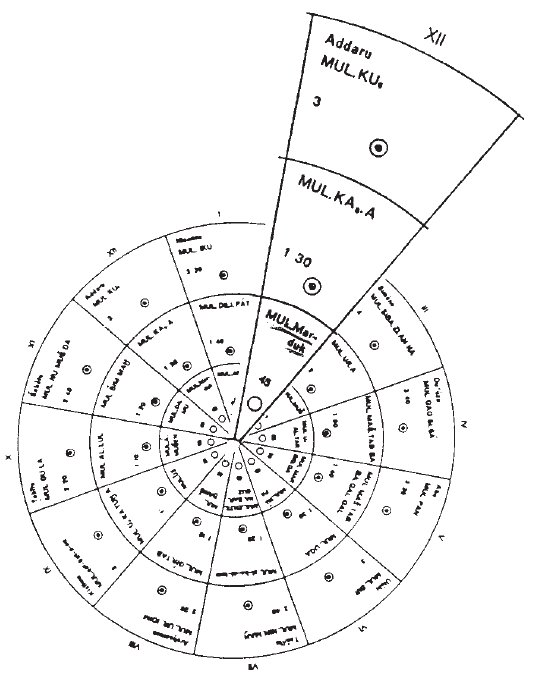
Figure 99
The change in name and position is absolutely correct if the two
astrolabes depict a moving planet—“Marduk” as it was called by the
Babylonians—that, after having come into view high in the northern
skies (as in “A”), curves down to cross the ecliptic and becomes
NIBIRU (“Crossing”) when it crosses the ecliptic in the Way of Anu
(as in “B”). The two-stage documentation by the two astrolabes
depicts precisely what we have been asserting all along!
The texts (known as KAV 218, columns B and C) accompanying the
circular depictions remove any shadow of doubt regarding the
Marduk/Nibiru identity:
[Month] Adar:
Planet Marduk in the Way of Anu:
The radiant Kakkabu which rises in the south
after the gods of the night finished their tasks,
and divides the heavens.
This kakkabu is Nibiru = god Marduk.
While we can be certain—for reasons soon to be given— that the
observations in all those “Late Babylonian” tablets could not have
taken place earlier than 610 b.c.e., we can also be sure that they
did not take place after 555 b.c.e., for that was the date when one
called Nabuna’id became the last king of Babylonia; and his claim to
legitimacy was that his kingship was celestially confirmed because
“the planet of Marduk, high in the sky, had called me by my name.”
Making that claim, he also stated that in a nighttime vision he had
seen “the Great Star and the Moon.”
Based on the Kepler
formulas for planetary orbits around the Sun, the whole period of
Marduk/Nibiru’s visibility from Mesopotamia lasted just a short few
years; hence, the visibility claimed by Nabuna’id places the
planet’s Return in the years immediately preceding 555 b.c.e.
So when was the precise time of the Return? There is one more aspect
involved in resolving the puzzle: the prophecies of “Darkness at
noon” on the Day of the Lord— a solar eclipse—and such an eclipse
did in fact occur, in 556 b.c.e.!
Solar eclipses, though much rarer than lunar eclipses, are not
uncommon; they happen when the Moon, passing in a certain way
between Earth and the Sun, temporarily obscures the Sun. Only a
small portion of solar eclipses are total. The extent, duration, and
path of total darkness vary from passage to passage due to the
ever-changing triple orbital dance between Sun, Earth, and Moon,
plus Earth’s daily revolution and its changing axial tilt.
As rare as solar eclipses are, the astronomical legacy of
Mesopotamia included knowledge of the phenomenon, calling it atalu
shamshi. Textual references suggest that not only the phenomenon but
even its lunar involvement were part of the accumulated ancient
knowledge. In fact, a solar eclipse whose path of totality passed
over Assyria had occurred in 762 b.c.e.
It was followed by one in
584 b.c.e. that was seen all across the Mediterranean lands, with
totality over Greece. But then, in 556 b.c.e., there occurred an
extraordinary solar eclipse “not in an expected time.” If it was not
due to the predictable motions of the Moon, could it have been
caused by an unusually close passage of Nibiru?
Among astronomical tablets belonging to a series called “When Anu Is
Planet of the Lord,” one tablet (catalogued
VACh.Shamash/RM.2,38—Fig. 100), dealing with a solar eclipse,
recorded thus the observed phenomenon (lines 19–20):
In the beginning the solar disc,
not in an expected time,
became darkened,
and stood in the radiance of the Great Planet.
On day 30 [of the month] was
the eclipse of the Sun.
What exactly do the words that the darkened Sun “stood in the
radiance of the Great Planet” mean?
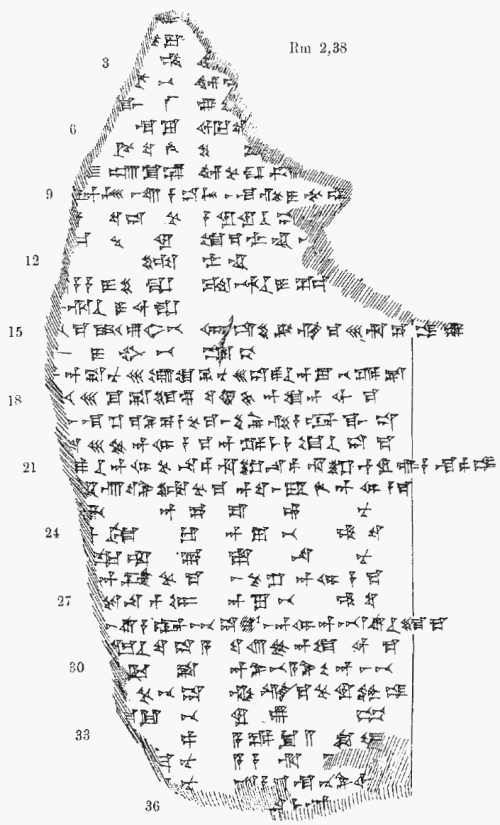
Figure 100
Though the tablet itself does
not provide a date for that eclipse, it is our suggestion that the
particular wording, highlighted above, strongly indicates that the
unexpected and extraordinary solar
eclipse was somehow caused by the return of Nibiru, the “great
radiating planet”; but whether the direct cause was the planet
itself, or the effects of its “radiance” (gravitational or magnetic
pull?) on the Moon, the texts do not explain.
Still, it is an astronomically historic fact that on a day equal to
May 19, 556 b.c.e., a major total solar eclipse did occur. As shown
by this map, prepared by NASA’s Goddard Space Flight Center (Fig.
101), the eclipse was a great
and major one, seen over wide areas, and a unique aspect about it
was that the band of total darkness passed exactly over the district
of Harran!
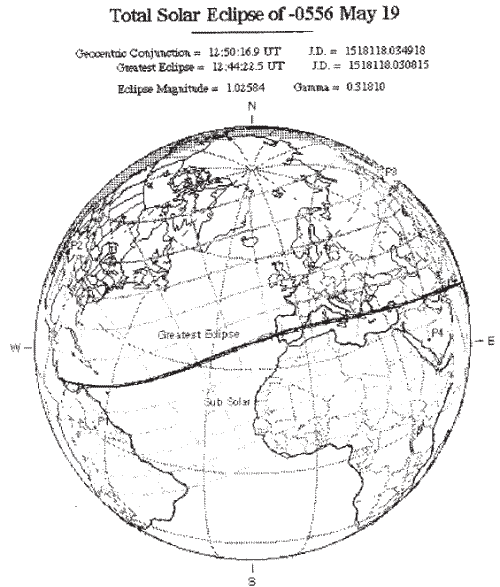
Figure 101
This last fact is of the utmost significance for our conclusions—and
it was even more so in those fateful years in the ancient world; for
right after that, in 555 b.c.e., Nabuna’id was proclaimed king of
Babylonia—not in Babylon, but in Harran. He was the last king of
Babylon; after him, as Jeremiah had prophesied, Babylon followed the
fate of Assyria.
It was in 556 b.c.e. that the prophesied Darkness at Noon came. It
was just then that Nibiru returned; it was the prophesied DAY OF THE
LORD.
And when the planet’s Return did occur, neither Anu nor any other of
the expected gods showed up. Indeed, the opposite happened: the
gods, the Anunnaki gods, took off and left the Earth.
Back to Contents
|












